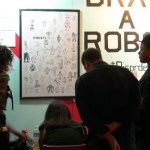Web 2.0, New Media, and Gadgets
Okay, if you're anything like me, you don't have time to read the blogs you already follow. But I do recommend that everyone head over to SEED's Revolutionary Minds Think Tank, where Greg Smith is guiding a conversation on visualizing science.
That's where I found the video above, demonstrating the UCSD Software Studies Initiative's application of "cultural analytics" to Rothko's paintings. When the paintings are treated as data points over an artist's career, they can be compared and contrasted in untraditional ways, revealing new patterns and anomalies. Awesome find!
Here, Smith responds…
The editors of the Columbia Journalism Review weigh in on the media's uneven treatment of the health care debate:
So far this year 55 percent of coverage of health care has been about the political battles, 16 percent about the protests, and only 8 percent about substantive issues like how the system works now, what will happen if it remains unchanged, and what proposed changes will mean for ordinary people. To help reporters understand and analyze the debate, The Commonwealth Fund has sponsored a special supplement to the September/October issue of the Columbia Journalism Review.
Supposedly…
This morning, I'd like to point out two interesting stories on how the health care debate has become more irrational than rational. First, a WaPo op-ed decrying the imbalanced media coverage of health care, which may be leading to a perception that opposition is larger than it really is:
The most disturbing account came from Rep. David Price of North Carolina, who spoke with a stringer for one of the television networks at a large town-hall meeting he held in Durham. The stringer said he was one of 10 people around the country assigned to watch such encounters. Price said he was told flatly…
It commemorates Hans Christian Ãrsted, who discovered the relationship between electricity and magenetism. Re-enact Ãrsted's experiment here.
But what about that other Hans Christian, Hans Christian Andersen? Here's what the Guardian had to say: "while there's nothing wrong with fairy stories, they haven't contributed much to the development of electric motors."
Ouch! :)
John Timmer at Ars Technica discusses the results of a survey of bloggers which seems to suggest that, while most bloggers hold themselves to a reasonably high ethical standard, they don't necessarily expect other bloggers to do so.
I think it's kind of a weird idea to have a code of ethics for all bloggers, but that's because blogs are so diverse, not because I can imagine a situation in which I'd be deliberately violating such a code. My blog is a sort of mashup of art review, musings on communications and policies, and science coverage, and they're all different sorts of posts. When I blog…
nmohan of the collaborative artists group Robot Disorder just contacted me to let me know they've launched the Robot Disorder 2.0 website, with more robot hordes (and easier navigation). He says they have literally thousands of robot drawings to clean up and post in the coming weeks, so if you haven't yet seen your personal robot, never fear - it's on its way.
And it's not too late to contribute your own robot to the project - just visit the top floor at Artomatic in Washington DC before July 5!
Nature has gone science journalism crazy, with no less than six new articles on the subject! My favorite is "Science Journalism: Toppling the Priesthood," by Toby Murcott, who argues that coverage of peer review is a necessary component of truly investigative, accurate science journalism.
I don't agree with everything Murcott says, but he makes some really good points:
Journalism is often described as history's first draft. Much contemporary science journalism, however, can be seen as a second, or even a third draft. Unlike reporters covering other fields of public life, science journalists…
Clocky sounds like R2D2 and looks kind of like an ATV's single-axled, pastel cub. In other words, it's really, really cute. Which is why when Clocky wakes you with its piercing warbles, crashes to your floor and rolls under your bed, you won't want to smash its little display with your fist. At least, we hope not! Click through for more details.
Clocky is a clock for people who have trouble getting out of bed. When the snooze bar is pressed, Clocky rolls off the table and finds a hiding spot, a new one every day. Clocky began as a class project. After graduating, Gauri Nanda turned Clocky…
I'm here in DC at the Newseum for the State of Innovation Summit, a collaboration between SEED and the Council on Competitiveness. The crowd is pretty awesome - right now Adam Bly, SEED's CEO, is sitting a few rows from me with E.O. Wilson. Earlier, Wayne Clough, Secretary of the Smithsonian Institution, talked about a conversation he'd had recently with Steven Chu about using the Smithsonian's resources to enhance public understanding of climate change. As he spoke, the intense sunshine of a summer day in DC played across the Smithsonian castle turrets directly behind him (the seventh floor…
Artomatic is one of my favorite things about DC: a cooperative unjuried art gallery in a vacant high-rise, staffed by artists, with live performances and mini-bars on every other floor. It's free (except for the bars). What's not to like? The icing on the top (floor) this year is Draw A Robot - a collective crowdsourced fundraising experiment by the team at RobotDisorder.com.
Draw A Robot is a deliciously haphazard mashup of new tech and low tech. Starting at the low tech end of the process, you sit down with the pens and paper provided at the Draw A Robot booth, and you - wait for it - draw…
In a new post, scibling Bora asks whether science blogs are "real" publications and should be cited in other publications - like research articles. That's an interesting debate, and I encourage you to participate. I'm not going to get into it right now. Instead, I want to quote this section of his post:
There is a very interesting discussion on this topic in the comments section at the Sauropod Vertebra Picture of the Week blog, discussing the place of science blogs in the new communication ecosystem and if a blog post can be and should be cited. What counts as a "real publication"? Is the…
One of the challenges we faced with our new blogosphere initiative, Silence is the Enemy, was how to mobilize people to do something about the plight of rape victims. It's not that people don't have empathy for rape victims; it's that the experience of living in a war-torn nation where rape and murder are routine facts of life is so foreign and horrifying to us, we tend to tune it out. Part of the way to deal with this is to give people a clear mission - something simple they can do; in our case, donating to Doctors without Borders (as I am for the month of June), or writing to Congress, or…
If you've been following the Jared Diamond/New Yorker controversy, or my ongoing posts on journalism vs. blogging (here, here, here, here, here), you might be intrigued by this conversation about the culture of fact-checking in journalism, between journalism professor Jay Rosen and programmer Dave Winer, in their podcast series Rebooting the News. Consider this riddle: how is fact-checking in journalism like (or unlike) debugging a computer program?
Here's Rosen's take on it:
One of the features of a rebooted news system would actually be borrowed from the tech world. And it's the notion of…
A quick note: remember I blogged about Crayon Physics a while ago? Well, Adrian wrote a massive review of the game at his blog. While he has reservations, he concludes,
Crayon Physics is worth more than a lot of other things you can buy for twenty American dollars, and it gave me days of genuine good fun, an outstanding aesthetic experience, one of the most inspired themes around, and the chance to exercise my own creativity in the level editor.
If you were interested in Crayon Physics, definitely check his review out.
This week, Nieman Journalism Lab is running a fascinating series of video interviews with the New York Times' R&D group on the possible future face of news media. I know - you're wondering why the supposedly financially moribund NYT is wasting money on nerds who play with Kindles. Who do they think they are, Google? But it might be a good strategy after all.
As Fortune and the Columbia Journalism Review recently pointed out, with outlets all around them slashing premium content (like science), the NYT's best strategy may be to instead become increasingly "elite:"
Meanwhile, the company is…
And if so, will it make us even stupider? Only one more week until we find out! This could be the datahead's ideal engine:
It'll tell you the family, genus, species, and caloric value of an apple, and it'll forecast Apple's stock price, but it won't give you apple pie recipes. It'll tell you the box office take of the first "Star Trek" movie, but it won't tell you the theater where you can see the newest "Star Trek" movie.But a technical audience is still big. This could unlock a lot of data that students, research assistants, lawyers, marketing managers, financial analysts, and scientists…
You've probably already heard that Merck and Elsevier are being called on the carpet for producing a medical "journal" - Australasian Journal of Bone and Joint Medicine - that appeared to be peer-reviewed, but was actually a marketing ploy to encourage doctors to prescribe Merck drugs. Ouch.
Elsevier told The Scientist,
"Elsevier acknowledges the concern that the journals in question didn't have the appropriate disclosures," the statement continued. "It is worth noting that project in question was produced 6 years ago and disclosure protocols have evolved since 2003. Elsevier's current…
I promised you some updates on the Google Books Settlement, so here you go. Things are definitely getting interesting.
First, I mentioned earlier that I was going to attend a panel on the Google Book Search Settlement here in DC, featuring representatives of Google, the publishers, and the Internet Archive. ITIF, which organized the panel, has made the entire thing available online; I've linked to it at the bottom of the post, because it's over an hour long.
Anyway, it was interesting to hear the (very civil) differences of opinion between Dan Clancy, the Engineering Director for Google Book…
How much more successful would Gravity's Rainbow have been if it were two paragraphs long and posted on a blog beneath a picture of scantily clad coeds? And why not add a Google search box?
Want to become a high-profile Twitter superstar? McSweeney's tells you exactly how. Maybe Google is making everyone stupid, but if so, the bar for a successful writer is now much lower! w00t!
We all know Twitter can be annoying, but is it really evil? During the past week, you may have heard that there is brand-new neuroscientific evidence proving exactly that. But the hype turns out to be just that: hype.
It all started with a press release from USC about an upcoming PNAS paper by Mary Helen Immordino-Yang and Antonio Damasio, entitled "Neural Correlates of Admiration and Compassion." The USC press release, which was picked up by EurekAlert and other outlets, says:
The finding, contained in one of the first brain studies of inspirational emotions in a field dominated by a focus…






